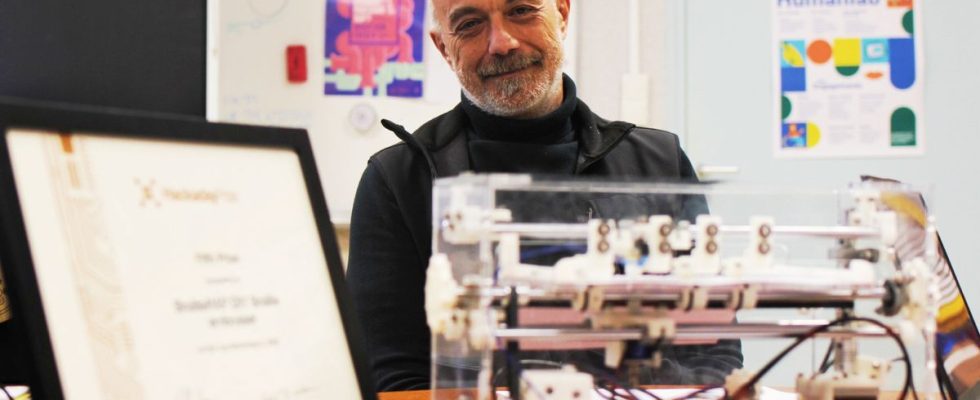It’s a simple transparent plastic box inside which we find some electronic components, faucet tubes and a printed circuit. An invention “made in Rennes” that could change the lives of thousands of people suffering from vision problems. In the Breton capital, however, no one has rushed to file a patent, nor to try to market this formidable object. Quite the contrary. Named “Braillerap”, this printer has the particularity of having been designed in open source, that is to say that all its plans will be shared throughout the world. The objective? May this invention be integrated “into the common good of humanity” and be able to serve as many people as possible, particularly the most disadvantaged. Focus in the small laboratory of a Rennes associationthe printer has just received a prize in the prestigious international Hackaday Prize competition, awarded in the United States.
Lots of points for knowing how to read
Two days after getting off the plane that brought him back from Los Angeles, Stéphane Godin still does not seem to realize what is happening to him. He, the computer scientist tinkering with machines, has just won an international prize for his “Braillerap”. “It is a machine that allows you to write Braille from more than 200 languages. All you have to do is enter your text into the computer and the printer will stamp it,” its designer modestly explains. “Stamp” or “emboss” or even “emboss” means that the machine is capable of translating a written text into Braille and printing it by marking the support with a multitude of small dots.
This tactile writing system was developed by Louis Braille in 1825. When he was only 16 years old, this young Frenchman had developed a six-point system allowing a text to be “translated” for the blind. and the visually impaired. With new printing tools, sufferers can also “see” what the outlines of a country look like or what shape an elephant has, just by touching a forest of small printed dots.
Very well known and used throughout the world, the braille system suffers from a serious handicap. It often requires a fairly substantial investment in printing machines that are not within everyone’s reach. Where printers generally cost 2,000 to 8,000 euros, the “Braillerap” stands out for its accessibility with a price not exceeding 250 euros. “Initially, it wasn’t me who had this idea. There were crazy people who wanted to make braille with nails and 3D printers. With a colleague, we wanted to stop tinkering and offer a more serious model,” says Stéphane Godin with a teasing smile. In France, it is estimated that only 10% of visually impaired people use Braille. This is due to the new tools that allow you to listen to the content of a book or a site, but above all to the lack of training for many people who are blind when they are elderly. But for all children and adults who know how to decipher it, this language is essential. Because it allows you to read.
“That people learn to do for themselves”
To develop his machine, the Rennes computer scientist contacted the “Human Lab” of the My Human Kit association, created at the initiative of Nicolas Huchet. Victim of a work accident when he was barely 20 years old, he had achieved the feat of developing an open source prosthesis, a sort of bionic hand accessible to all. For around ten years, his association has been working to make life easier for people with disabilities by developing adapted tools designed in its “fab lab”, a tinkering workshop where all kinds of inventors come together. . “The goal of open source is to spread, to swarm, that people learn to do on their own,” says Hughes Aubin.
This digital specialist has long worked to ensure that new technologies come to the aid of the world. Since the beginnings of the Braillerap printer, he has continued to travel to promote it. In Cameroon or India, he, with Stéphane Godin, trained local populations in the design of the open source printer by sharing the plans imagined in Rennes. “We bring in the pieces and spend two days explaining how to put them together. The goal is for everyone to be able to understand how the machine works in order to be able to repair it. In Cameroon, we cannot have parts delivered like we do here.” The machine also has the advantage of being able to print on materials other than paper, such as the aluminum of a can for example.
Currently, around twenty “Braillerap” printers are already in operation in Argentina, Egypt and even the small Buddhist kingdom of Bhutan. The inventors of this new typewriter hope that the price obtained in the United States will give them better international visibility. “This project must be universal, it must be made known because it can help children to read,” recalls Stéphane Godin. “When we talk to visually impaired people, we understand that their life sometimes resembles an obstacle course. So, if we can help them a little…” concludes Hugues Aubin.

